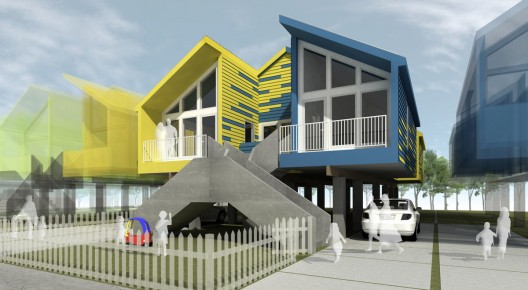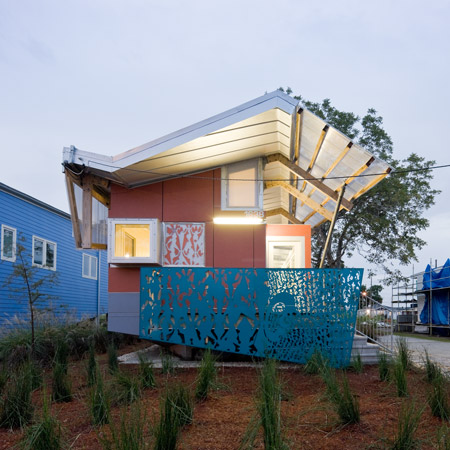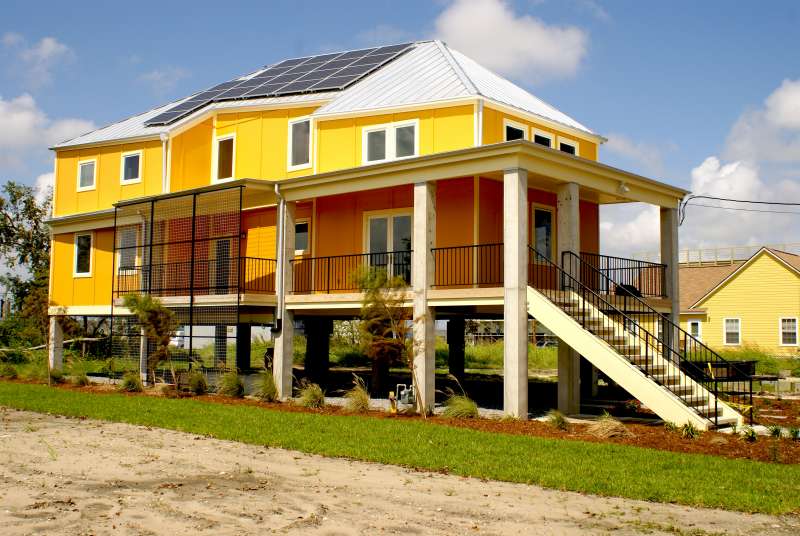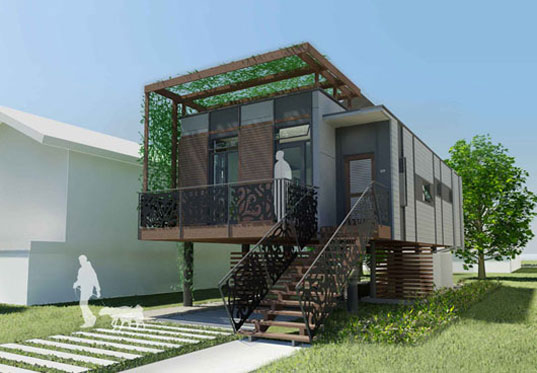The tragedy of Hurricane Katrina motivated a help thy neighbor spirit among Americans that is rarely seen in today's society, and the efforts of actor Brad Pitt are those of extreme exception. His unparalleled commitment and profound imagination has presented one of the most remarkable cities in the world with an extraordinary lift in spirit, community, and, what truly is, Hope.
The Lower 9th Ward houses of Pittís nonprofit Make it Right Foundation Ė individualistic and energy-efficient Ė are among the most inspired responses to the stormís ravages. The bright and engaging facades of these new homes gives a needed asthetic energy to not only the 9th ward itself, but boosts the moral of it's residents and investors.
In the hurricane that must be his own lilfe-5 kids, an A-list movie career and other obligations- Mr. Pitt has not in the slightest wavered from the promises he made to New Orleans and the Make it Right Foundation. In the 5 years since the storm, the progress may be slower than some would like, but it is being done well...from conception to construction. Most of all; his pledge to, well, Make it Right, is strong with loyalty.
New Orleans New 9th Ward:




Please take the time to read some thoughts of Mr. Pitt, as he sat down to talk with longtime friend, historian Douglas Brinkley.
Credit: Douglas Brinkley/ Times-Picayune
Tell me about your love affair with New Orleans. Youíve become perhaps the cityís most effective booster. How did that happen?
I came to New Orleans back in 1994 doing the "Interview with the Vampire" movie, based on the Anne Rice novel, and fell in love with the city. It got under my skin. Everything was sexy and sultry. Iíd ride my bike all over the place, amazed by the architecture. Iíd return to New Orleans every chance I could. What can I say; itís got the best people, the best everything. Itís the most interesting city in America.
Where were you when Hurricane Katrina hit on Aug. 29, 2005?
In Calgary, up in Canada, making the movie "The Assassination of Jesse James." I couldnít get my eyes off the TV. It was frustrating seeing all those people on rooftops screaming for help. It was abhorrent. I was gutted. I remember thinking we can do better in America. Everybody seemed to make mistakes at a federal, local and state level. I used to ride my bike around the Lower 9th ó usually going to the Holy Cross area to look around. My instinct said that we have to find a way for those people to find a road home. New homes were clearly going to be needed.
When did the idea of Make It Right houses come into focus?
I got involved with Global Green and various Bill Clinton initiatives. I met a lot of smart people. But nobody was doing what I thought needed to be done. Look, Iím an architecture junkie. And the holy grail of architecture is finding ways to design sustainable urban communities. The Lower 9th had become a clean slate. Everything had been washed away. So quite naively ó and I know Iím naive ó I said letís start at ground zero, the very historic neighborhood that got devastated by Katrina. We brought architect William McDonough into the picture and things took off. We started building prototypes. The Lower 9th is the iconic spot of Katrina. Itís where the levees breached. It represents a marginalized people stuck in a man-made disaster. I met Katrina victims who had been given FEMA trailers and had nothing to hook them up to. Others had formaldehyde problems. What was the message? We were telling people to come home and yet when they got back to New Orleans they were treated in a substandard way. I just thought it was atrocious.
How do you feel seeing those Lower 9th families living today, on the fifth anniversary of the storm, in beautiful Make It Right houses?
Great! I was in the Lower 9th for Memorial Day. Families were barbecuing and swimming in the little, you know, pop-up swimming pools. And families were coming together and saying hi. You know, the simple acts of kindness. A lot of residents no longer have only a cynical view of Katrina, they have a brighter perspective about life. And when I say kindness I mean Make It Right was built on the donations of people. Americans donated. That has a deep effect on the people living in these homes. We have solar panels providing the energy, and it works and fellow Americans paid for it. Not the government.
When you came down from Calgary to see the Lower 9th in person back in 2005, were you shocked?
Yeah. It was, like I said, a blank canvas. It was obliterationville. It was a blank, blank, blank canvas. A house sitting on top of a house on top of a house sitting on top of a station wagon with a boat jammed through it. It was, you know, shocking devastation. The place looked like a giant eraser had come in and just erased away those homes. You know, these werenít just houses. These were peopleís lives shattered. Families in pain, memories washed away, just obliterated.
A lot of people saw the devastation in the Lower 9th. But only you acted on rebuilding it?
OK, I was naive, totally naive. I credit naivete with our success. I was also an opportunist. I saw this land, it was available, and I thought we could make a difference. Starting from scratch has its benefits. Too often we give disaster victims cheap building products, slipshod materials, and then put on top of them the burden of energy bills and medical bills. You know itís the badly built levees that destroyed these peopleís lives. We needed, as a country, to do something right for them. A new paradigm was needed. The technology was available. So I thought, ĎLetís build houses that answer all the problems.í We needed to make amends for over 1,500 deaths. We had to fix the grave injustice the best we could. Letís face the facts: Shoddy Army Corps levee work was the culprit behind the 2005 flooding of New Orleans. People in pre-Katrina had been sold cement slabs in the Lower 9th next to the levee. These folks were told itís all right to build homes, for example, on Tennessee Avenue. They were set up. I mean not necessarily intentionally, but through the negligence of levee maintenance. But, lo and behold, the Lower 9th is now the greenest ó I donít even like the word green ó itís the most high-performing clean neighborhood in the world, according to the Green Building council.
Are you hoping this can be a pilot project or prototype community to develop elsewhere? Do you have a global vision?
That was the plan. That was the plan all along. This thing could become a template for other communities to follow. And weíve trained New Orleans contractors on how to build these homes.
When did you decide to be a New Orleans homeowner?
Iíve always wanted to have something there. I had looked into
some properties in the late '90s and almost bought a home. But my personal life didnít make it possible then. After Katrina, in 2006, it just became a need. I needed to be down in the Lower 9th and I wanted to make films in New Orleans because I love being in the city so much.
Letís get down to brass tacks. What is your favorite restaurant? Or give a call-out to perhaps two or three.
Well, we used to eat a lot at the Verti Marte. Dirty Verti. It was just a little bitty market right there on Governor Nicholls. A little bitty market with great shrimp po-boys that I couldnít get enough of. It recently had a fire problem. But after that, we like Ireneís a lot. Antoineís and the Windsor Court. There are so many. But, in general, shrimp po-boys. I order them everywhere.
Can you still get around New Orleans on your bike? Do you put a sweatshirt hood over your head? Or does your facial hair serve as a disguise?
In New Orleans, the people are great. They leave Angie and me alone. Unfortunately, we drag paparazzi with us from other places in the world. They become a bit of a hindrance. We try to go out and all the locals are so great, and then these paparazzi ruin it. But otherwise, man, we can just live and breathe and ride bikes. We can take our kids on bike rides, and local people just give us a shout outóand let us move on. Itís very free for us in New Orleans, very nice for us. Itís like Venice or Rome; an essential world city. So we feel honored to be involved with the community. Everybody treats us like neighbors.
How do you feel about the grass-roots movement of Brad Pitt for U.S. senator or mayor of New Orleans?
Yeah, with my past? (Laughs). It isnít going to happen. Oh, my, the skeletons that would come out of my closet. Thatís a losing venture.
How about the Saints? Are they going to win the Super Bowl again this year?
Man, Iím looking forward to the season. I cannot wait, cannot wait. I cannot wait for Game 1 against Brett Favre ó I canít wait.
What did the Saints winning the Super Bowl mean for the city?
It meant no matter what adversity humans face, they can turn it around with hard work. It symbolized us picking ourselves up. I find it heroic. It just represents human nature at its best. That we can pick ourselves up when weíre down. Itís like the Book of Job. The Saints helped this city turn a great atrocity around by bringing people together. The Super Bowl in some way, Iím not exactly sure why, was about the human spirit prevailing.
Is there a particular Saints player that youíve become fond of? Or maybe a few players?
Well, you have got to give it up to Drew Brees, the most accurate quarterback in the entire NFL, staggering numbers. I mean you also have got to give it up to the defense. It goes on the attack like gangbusters. And you have got to give it up to Sean Payton. The best coach in the NFL, bar none. We always like to see Reggie (Bush) in there. He did the job when we needed him.
Did something in your Missouri upbringing connect you emotionally to New Orleans?
Yeah, there is a strain of that. New Orleans holds a southern mentality but also an East Coast mentality regarding the importance of art and culture in life. Somehow Springfield, Mo. ó in the southern part of the state ó seemed more connected down the interstate to New Orleans than St. Louis or Kansas City. Itís a Southern thing in me.
When youíre working in L.A. or Europe, do you listen to New Orleans music?
Truthfully, my favorite sound in the entire world is opening up the balcony doors in the French Quarter and hearing four different sounds playing at once from the apartments across the way or down the street. Or, you know, behind our house. And itís a balmy night, twilight, and Iím drinking a beer and this feeling just falls over me, of contentment. It gives me goose bumps to talk about it.
If you had a magic wand, what would you want to see happen in New Orleans during the fifth anniversary commemorations?
Iíd like to see more people still be able to get back. More specifically, for our Make It Right project, I would like to expand our template to St. Bernard Parish. You know, out of all the Lower 9th homes we built, all are producing more energy than they are spending, than they are consuming. Theyíre all pollution-free. This is an amazing story to me. Many of our homeowners donít owe anything for energy use. We can prove that low-income and high-performance houses work. No more antiquated building practices are needed in New Orleans; letís put that one behind us. Weíre on track to build more homes in the Lower 9th and perhaps in St. Bernard Parish. We are getting the prices down. All our safety measures are intact. I hope house experts will come look. I can back up what Iím saying. Our homes are affordable, high-performance, and safe. And there is an aesthetic to them all. Now I want to drive the price down. OK, that is fair to say, the price needs to come down. But any other criticism you hear doesnít hold up.
What do you say to people who donít think the Lower 9th is safe because the levees are still weak? How do you know the wall wonít collapse again in a Category 3 or 4 or 5 hurricane?
Sure, I have concerns. I mean it was the first question we had to ask: Are we putting people back into the danger zone? Well, there is a Road Home program. Nobody is giving them enough money to return safely. In our eyes, youíre setting people up for another catastrophe. Our houses are built high enough from the ground to endure flooding if the levees donít hold up. As for the iconic Industrial Canal breach spot? Itís been dealt with by engineers to a large degree, dealt with better than the other walls. You know what my worry is? My worry is not the Lower 9th, itís the upper 9th. Because that protection wall wasnít dealt with. Itís a foot or two lower than the levee in our neighborhood. If the Army Corps would just have spent a little bit more time, put in a little more focus and a little bit more money and done it right the first time, New Orleans would be a far safer place. And it wouldnít have cost the billions of dollars to fix what was wrong. And I find that inexcusable. So our Make It Right homes are built right. And thatís where the title came from: Make It Right. Just make it right for everybody. Make things fair to the people of New Orleans. Make it right.
http://www.makeitrightnola.org/